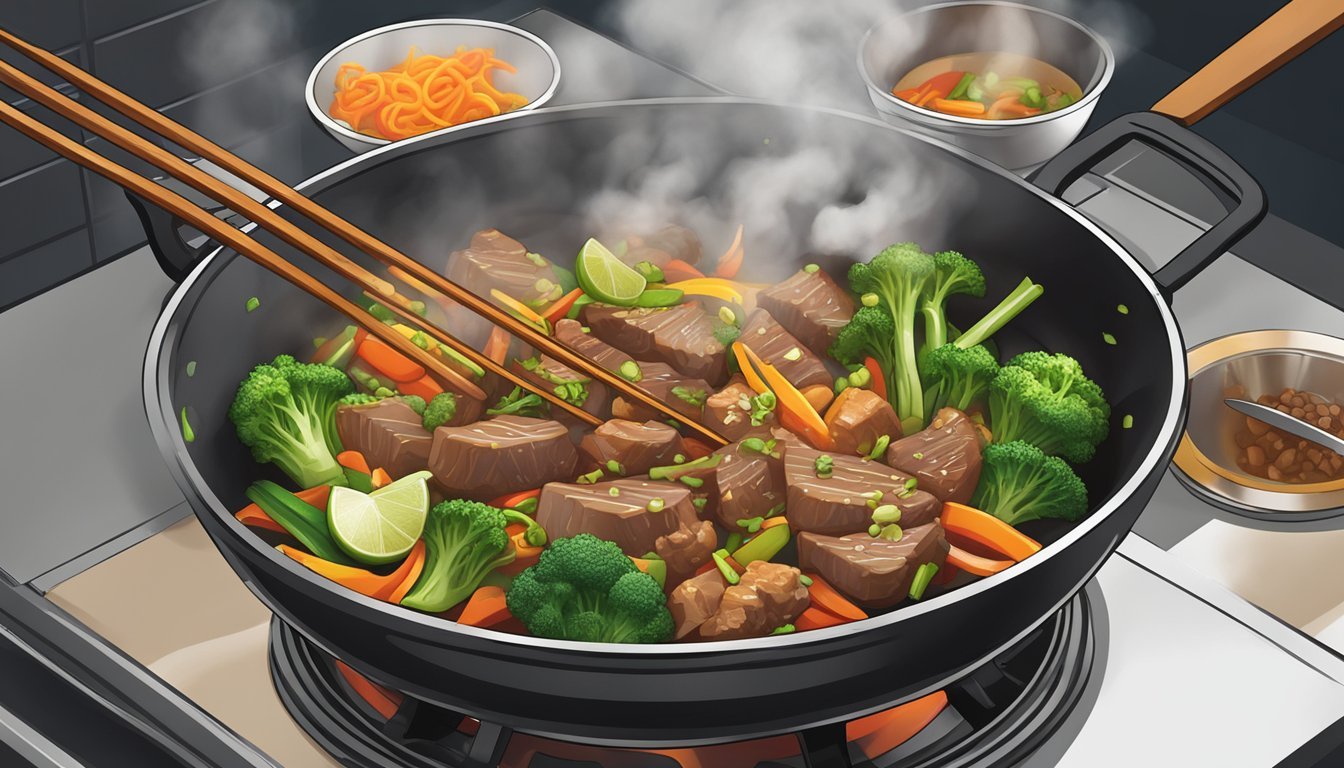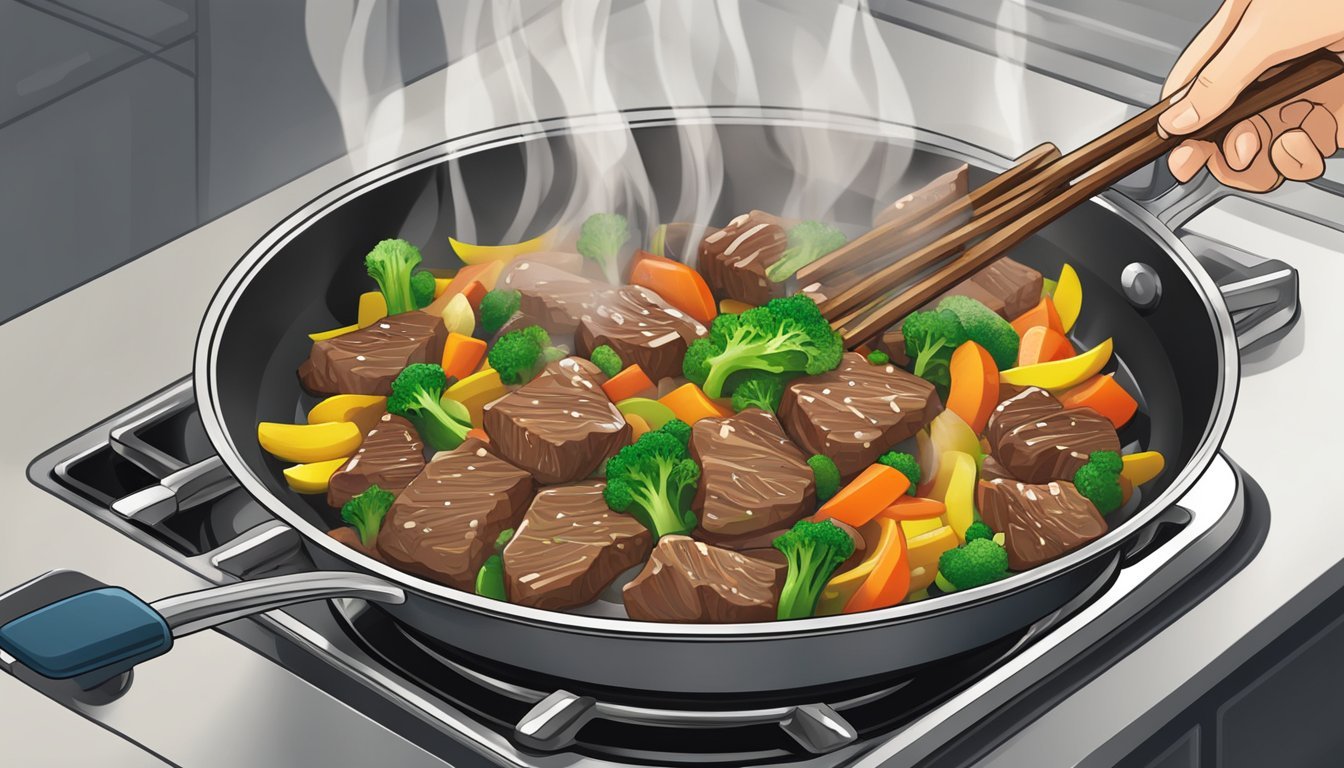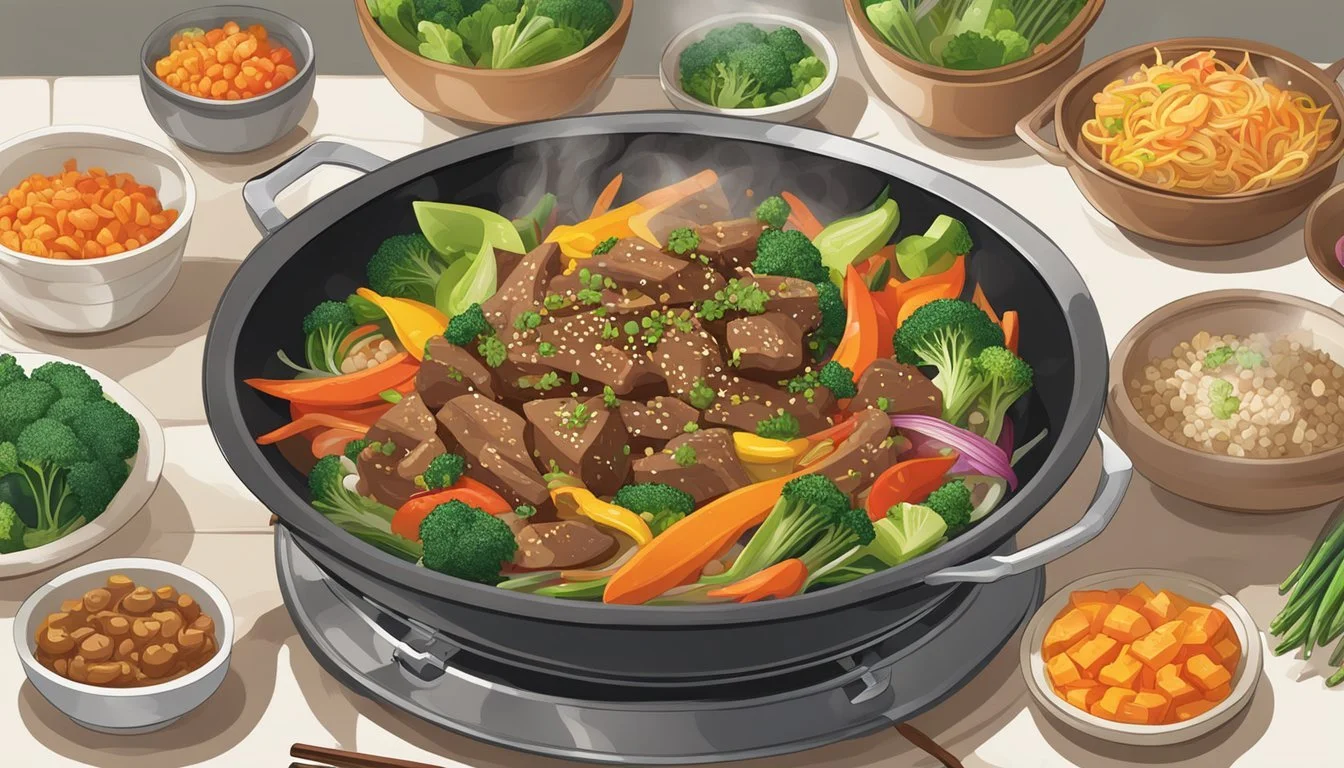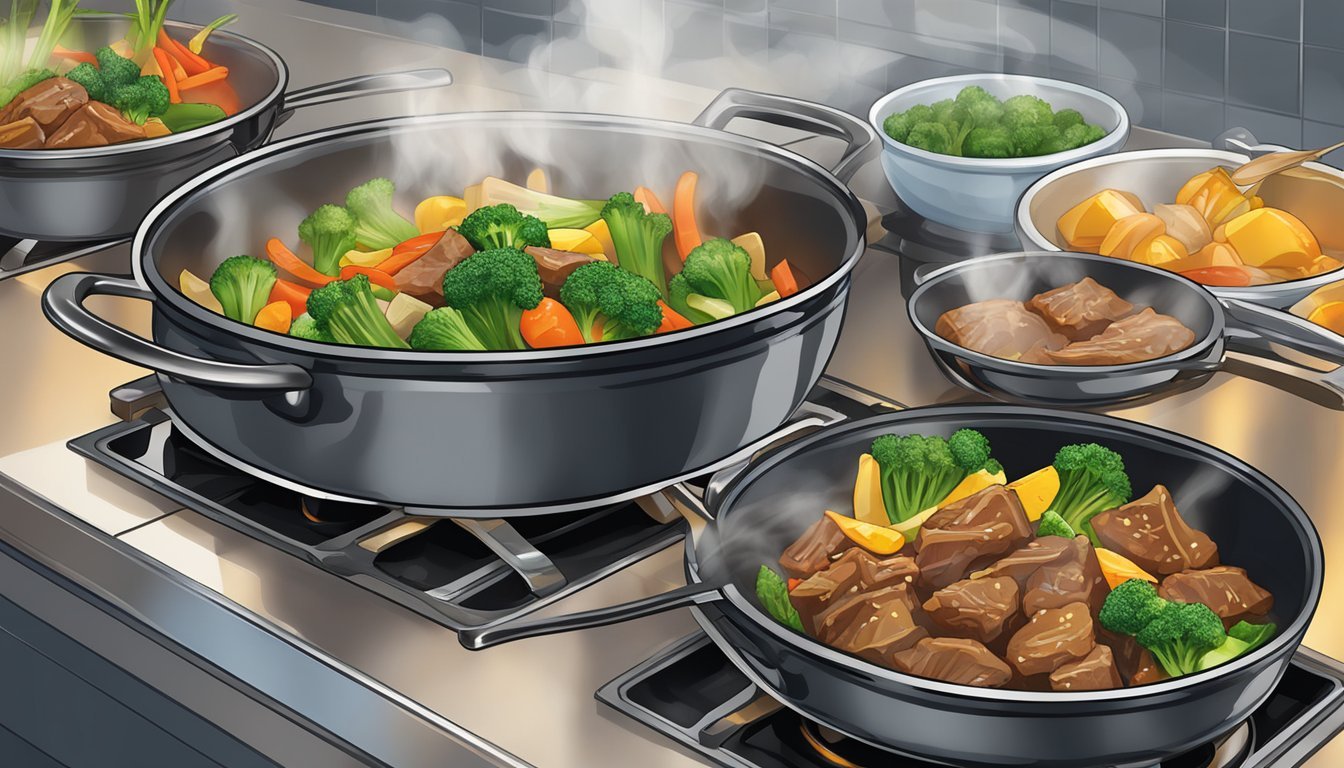Best Way to Reheat Ginger Beef Stir-Fry
Ensuring Tender Meat and Crisp Veggies
Reheating ginger beef stir-fry without losing the succulence of the tender meat and the crispness of the vegetables is an art that ensures leftovers are just as enjoyable as when the dish was first made. The key is to apply the correct reheating method that allows the flavors to meld together while retaining the texture of the ingredients. Proper reheating techniques can revive the vibrant flavors and textures of ginger beef stir-fry, making it a delightful meal even after it has been stored in the refrigerator.
Preserving the integrity of the beef and vegetables requires a gentle approach to reheating. Each component of the stir-fry needs to be considered to ensure that the beef remains tender and the vegetables stay crisp. Using the right amount of heat and timing can prevent the beef from becoming tough and the vegetables from turning soggy. Achieving this balance is essential for a perfectly reheated stir-fry that echoes the freshness of its initial preparation.
Understanding Reheating Basics
The process of reheating ginger beef stir-fry properly is essential for maintaining its delicious qualities. Mastering the technique and understanding health considerations are crucial steps to enjoy a satisfying reheated meal.
Importance of Reheating Technique
Reheating techniques directly influence the texture and flavor of ginger beef stir-fry. Tender beef and crisp vegetables hinge upon the method chosen:
Skillet: Using the skillet with a bit of oil ensures even heating and helps preserve the meat's tenderness and the vegetables' crispness.
Microwave: A microwave can be used for convenience, though care must be taken to avoid overcooking. Use medium power and short bursts of time, covering the dish with a paper towel to retain moisture.
Oven: Reheating in an oven set to 350ºF allows for a gentler warming process, especially when the food is evenly spread on a tray and lightly moistened.
Health and Safety Considerations
Food safety should be at the forefront when reheating any dish. It is vital to ensure the stir-fry reaches 165ºF throughout to prevent foodborne illness. Here are key safety tips to consider:
Temperature: Always reheat to the recommended temperature to eliminate foodborne pathogens.
Timeframe: Leftovers should be eaten within 3-4 days, stored in the refrigerator at or below 40ºF.
Moisture: Add a splash of water or broth if the leftovers appear dry to prevent overcooking and drying out, which can compromise both taste and safety.
Preparation for Reheating
Proper storage and reheating techniques are essential to preserve the texture and flavor of ginger beef stir-fry. This section outlines the optimal practices for storing leftovers and selecting an appropriate reheating method.
Storage Tips for Leftovers
Cool Down: Leftovers should be allowed to cool to room temperature before storage to prevent bacterial growth and moisture buildup.
Refrigerator Storage: Place the ginger beef stir-fry in a shallow, airtight container before refrigerating to maintain freshness.
Freezer Storage: For longer storage, wrap the stir-fry in aluminum foil or store it in freezer-safe bags, squeezing out excess air before sealing.
Choosing the Right Reheating Method
When reheating ginger beef stir-fry, one should match the reheating method to the dish's components to ensure tender meat and crisp vegetables.
Microwave: Use a microwave-safe dish, cover with a paper towel to retain moisture, and reheat on medium power evaluating doneness every 30 seconds.
Stovetop: A skillet or wok, preheated on medium heat, is the most similar method to the original cooking process and can help in retaining the stir-fry's texture.
Oven: Preheat the oven and spread the stir-fry on a baking sheet. Covering with aluminum foil can prevent it from drying out.
Air Fryer: For smaller batches of leftovers, an air fryer can quickly crisp up the vegetables while heating the meat through.
Avoid Crockpot: It is not recommended to use a slow cooker such as a crockpot, as it may overcook the stir-fry, making the meat tough and the vegetables soggy.
Reheating on the Stovetop
To achieve the best results when reheating ginger beef stir-fry, one should utilize either a wok or skillet and carefully manage heat levels. This approach preserves the tenderness of the meat and the crispness of the vegetables.
Using a Wok or Skillet
Preparation: Place a wok or skillet on the stove and allow it to heat up on medium heat.
Oil: Once the pan is hot, add a small amount of oil to coat the bottom.
Reheat: Add the ginger beef stir-fry to the skillet and stir consistently for even heating.
Using a wok or skillet is advantageous due to their high sides and even distribution of heat, which aids in quick reheating without overcooking the stir-fry.
Managing Heat Levels
Heat Settings: Use a medium heat setting to warm the stir-fry; this avoids burning or overcooking.
Stirring: Stir the stir-fry occasionally to ensure that the meat and vegetables reheat uniformly.
Observation: Keep a close eye on the stir-fry, adjusting the heat as necessary to prevent sticking or charring.
By managing heat levels attentively, one ensures that each component of the stir-fry reaches the ideal serving temperature, preserving its flavors and textures.
Reheating in the Microwave
When reheating ginger beef stir-fry in the microwave, the goal is to warm the dish evenly while maintaining the tenderness of the meat and the crispness of the vegetables. The correct technique involves the use of microwave-safe dishes and attention to power levels.
Avoiding Sogginess
To prevent sogginess, particularly in the vegetables, one can take the following steps:
Add a Small Amount of Water: Sprinkle a little water on the stir-fry before placing it in the microwave. This creates steam during the reheating process and avoids dryness.
Use Paper Towels: Cover the stir-fry with a paper towel. It helps in absorbing excess moisture and prevents the microwave from turning the dish soggy.
Microwave Reheating Technique
The technique is essential to reheat the dish effectively:
Place Stir-Fry in Microwave-Safe Dish: Transfer the ginger beef stir-fry to a dish that is safe for use in the microwave.
Reheat on Medium Power: Set your microwave to 50-70% of its full power. Reheating on full power might overcook the meat and vegetables.
Cover and Heat: Cover the dish with a microwave-safe lid or vented plastic wrap. Heat in short intervals of 90 seconds to two minutes, checking and stirring between each interval to ensure even reheating.
Final Check: After reheating, let the stir-fry rest for a minute before checking if the meat is warm and vegetables are crisp to your liking. If more heating is needed, continue with 30-second bursts.
By following these steps, one can reheat ginger beef stir-fry in the microwave while preserving its quality as much as possible.
Reheating in an Oven or Toaster Oven
When reheating ginger beef stir-fry, using an oven or toaster oven can maintain the tenderness of the meat and the crispness of the vegetables if done correctly.
Setting the Correct Temperature
To preserve the quality of ginger beef stir-fry, the oven should be set at a low temperature to reheat the dish slowly and evenly. Here are the recommended steps:
Preheat the oven to 275°F (135°C). This temperature is warm enough to heat the dish gently without overcooking the components.
Arrange the stir-fry in a single layer on a baking dish to ensure uniform heating.
Tip: Check the stir-fry periodically to prevent the risk of drying out the beef or over-wilting the vegetables.
Using Aluminum Foil for Even Heating
Aluminum foil can help distribute heat more evenly and retain moisture when reheating ginger beef stir-fry.
Cover the baking dish containing the stir-fry with aluminum foil.
The foil should be sealed tightly around the edges to trap steam, which keeps the meat tender and the vegetables crisp.
Place the covered dish in the preheated oven.
Remember: Use the foil to create a tent over the stir-fry to avoid the food from sticking to the foil and to allow space for steam circulation.
Reheating Using an Air Fryer
When reheating ginger beef stir-fry in an air fryer, the user's primary goal is to maintain the dish's tender meat textures and the vegetables' crispness. The air fryer's rapid air circulation is suited to achieve these results efficiently without overcooking.
Achieving Crispiness
To ensure the vegetables regain their crispiness without becoming soggy, the user should reheat the ginger beef stir-fry at a temperature that is not too high, as excessive heat can cause the dish to dry out. A moderate temperature setting helps in recrisping the vegetables while keeping the beef tender.
Recommended Temperature for Crispiness:
Vegetables in Stir-Fry: 350°F (175°C)
By using these settings, the user can achieve a balance where the vegetables crisp up without compromising the moisture of the beef.
Air Fryer Reheating Technique
Proper technique in an air fryer is crucial for reheating leftovers to perfection. Below is the suggested method for reheating ginger beef stir-fry:
Preheat the Air Fryer: Set the temperature to 350°F and allow it to warm up for a few minutes.
Prepare the Leftovers:
Spread the ginger beef stir-fry in a single layer in the air fryer basket to promote even reheating.
Reheating Process:
Cook the leftovers for 3 to 4 minutes, then check their warmth and crispness.
If necessary, shake the basket to redistribute the stir-fry for even heat exposure, and continue reheating for an additional 1 to 2 minutes.
By following these instructions, the user should be able to reheat their ginger beef stir-fry effectively, preserving its quality and ensuring the dish is evenly warmed and enjoyable.
Ingredients and Seasoning Considerations
When reheating ginger beef stir-fry, one must carefully consider the properties of the proteins and vegetables to maintain the dish's integrity. Precise application of heat and attention to seasoning can impact the final quality significantly.
Reheating Different Meat Types
Beef: It's crucial to reheat beef to a temperature that restores its tenderness without overcooking. Thin slices of beef quickly regain warmth, so a brief reheating period is ideal.
Method: Pan-frying over medium heat for a few minutes should suffice.
Chicken: If chicken is part of the stir-fry, it requires delicate reheating to avoid dryness.
Method: Gentle heating in a covered pan with a splash of water helps maintain moisture.
Preserving the Flavors of Vegetables
Stir-fried vegetables should retain their crispness even after reheating. Overheating can lead to soggy textures.
Crisp Vegetables: Examples include bell peppers and snow peas. These should be reheated quickly over high heat.
Soft Vegetables: Such as mushrooms, can tolerate a bit more heat, but still require careful monitoring.
Additional Seasoning Tips
During reheating, flavors may mellow. Here's how to revive them:
Soy and Oyster Sauce: Restore umami by adding a teaspoon if the flavor has diminished.
Hoisin Sauce: A dollop can bring back a touch of sweetness and depth.
Sesame Oil: Drizzling a small amount after reheating enhances aroma and richness.
Overall Flavor: Assess and adjust seasoning cautiously post-reheating to avoid overpowering the dish.
Serving and Presentation After Reheating
Once the ginger beef stir-fry is properly reheated, maintaining the tenderness of the meat and the crispness of the vegetables, it's crucial to serve it in a manner that retains its allure. Start by selecting the right dish; a large, flat platter showcases the colorful stir-fry attractively, while keeping the components evenly spread for consistent temperature.
The aesthetic of ginger beef stir-fry can be enhanced with garnishes that add color and texture without overwhelming the dish's flavor. Consider the following garnishes:
Sesame seeds: A sprinkle adds a subtle nuttiness and visual appeal.
Green onions: Chopped for a sharp contrast and freshness.
Cilantro leaves: For a burst of color and a hint of citrus.
Red pepper flakes: For an extra kick, if desired.
Here's a table to guide presentation enhancements:
Enhancements Purpose Platters Distribute heat evenly Garnishes Enhance visual and textural contrast Drizzle Add a light soy or teriyaki sauce glaze
To ensure preservation of the meal's quality, serve the stir-fry immediately after reheating. Doing so guarantees that guests enjoy the optimal balance of tender meat and crisp vegetables. If the stir-fry cannot be served right away, cover the dish loosely with foil to retain heat without causing steam that might soften the vegetables.
In terms of portioning, use tongs or a large serving spoon to gently lift the stir-fry onto plates, being careful not to crush the vegetables or break apart the meat. The ginger beef stir-fry should be the shining star of the meal, so plate it as such – front and center, with complementary sides such as rice or noodles served in smaller portions alongside.
Troubleshooting Common Reheating Issues
Reheating ginger beef stir-fry can present challenges, such as overcooked protein and flavor loss. This section provides specific strategies to manage these issues and ensure a more enjoyable meal.
Dealing with Overcooked Protein
When reheating stir-fry, the risk of overcooking the beef and making it tough is high. To prevent this:
Lower the Heat: Reheat on a low-to-medium setting.
Short Heating Times: Heat it only until it's just warmed through, which often requires only a minute or two.
Solutions for Dried-Out Stir-Fry
A common mistake that leads to dry stir-fry is not adding moisture back into the dish. To remedy this:
Add Liquid: Introduce a small amount of broth or water before reheating.
Cover While Heating: This traps steam and helps to redistribute moisture.
Reviving Flavor Losses
Stir-fry may lose some of its robust flavor after storage. To bring it back:
Add Fresh Ingredients: A dash of fresh ginger or soy sauce can enhance the original flavors.
Re-season Lightly: A pinch of salt or a sprinkle of fresh herbs can revive the dish without overpowering it.
Frequently Asked Questions
When reheating ginger beef stir-fry, preserving the quality of the meat and vegetables is of utmost importance. This FAQ section delves into the best methods to ensure takeaway stir-fry retains its flavor and texture, the optimal way to reheat dishes that include noodles or rice, and considerations for vegetarian or special diet adaptations during the reheating process.
Best Practices for Reheating Takeaway Stir-Fry
To reheat takeaway stir-fry while maintaining the meat's tenderness and the vegetables' crispness, start by heating a skillet on medium-high heat. Adding a small amount of oil can prevent sticking and help restore texture. Stir continuously for even heating, and avoid the microwave which can unevenly cook and make the ingredients soggy.
Skillet: Medium-high heat with a touch of oil.
Microwave: Not recommended for best texture preservation.
Reheating Stir-Fry with Noodles or Rice
For stir-fries that include noodles or rice, one must be cautious to avoid overcooking which can lead to mushiness. Using a skillet with a bit of oil typically yields better results than a microwave. If the rice or noodles appear dry, lightly sprinkle some water before reheating.
Noodle Stir-Fry: Briefly sauté in a skillet to prevent stickiness.
Rice Stir-Fry: Add a splash of water and cover to steam the rice evenly.
Vegetarian and Special Diet Considerations
Vegetarian stir-fries require a gentle reheating approach to keep vegetables vibrant and crunchy. Dishes with tofu or other protein substitutes should be heated just until they are warm to maintain their intended texture. It is always beneficial to check the ingredients for any special dietary needs before adding oils or seasonings during the reheating process.
Vegetable-Only Stir-Fry: Light oil, medium-high heat, and quick sauté.
Special Diets: Confirm ingredients for compliance with dietary restrictions.
Nutritional Information and Adjustments
When reheating ginger beef stir-fry, it is important to remember that the nutritional content can be affected, and certain adjustments may be needed to cater to dietary restrictions.
Calculating Nutritional Changes Post-Reheat
Calculating the nutritional changes after reheating involves understanding that the process may alter the moisture content and thus the concentration of nutrients. For instance, sodium and sugar levels might slightly increase per bite if the dish loses water content. Conversely, some vitamins are sensitive to heat and may degrade, potentially altering the micronutrient profile. Additionally, using oils while reheating may add extra calories and fat.
One must accurately measure portions before and after reheating to compare nutritional values effectively. They can use nutritional databases to estimate changes in key components like fat, calories, and sodium.
Adjusting for Dietary Restrictions
For those with dietary restrictions, certain tweaks to the reheating process can help maintain nutritional balance:
Low Sodium: If the reheated dish requires additional seasoning, opting for low-sodium alternatives or aromatic herbs can prevent sodium levels from becoming too high.
Sugar Control: Adding fresh vegetables can dilute the overall sugar content per serving, assuming no additional sauces with high sugar are used.
Fat Reduction: To minimize additional fat, reheating the stir-fry in a nonstick skillet with minimal or no added oil can keep the fat content in check.
Individuals can make adjustments to meet their dietary needs, such as:
Using a trace amount of high-quality oil for reheating if one is monitoring fat intake.
Introducing fresh, steamed vegetables for those who need extra fiber without significantly impacting the calorie content.
By being mindful of these variables, one can enjoy reheated ginger beef stir-fry while adhering to their specific nutritional requirements.







